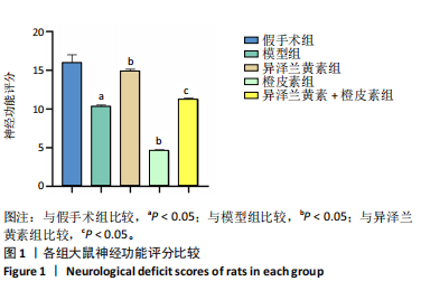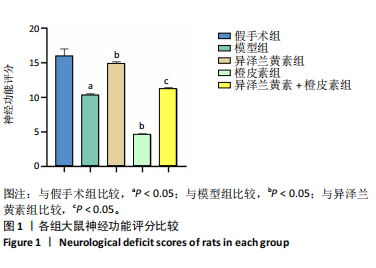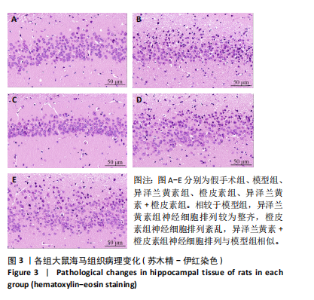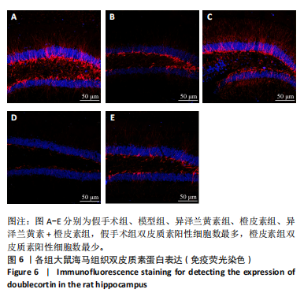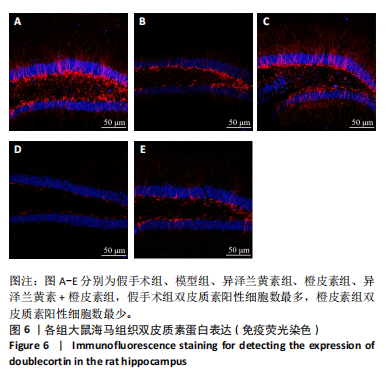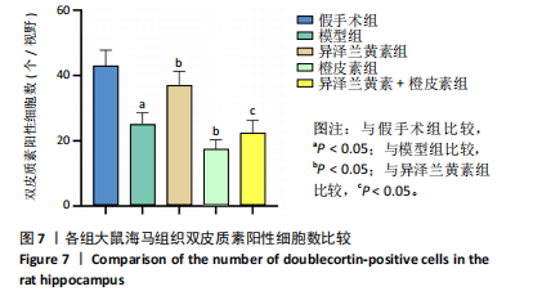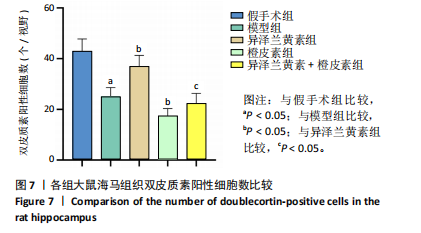Chinese Journal of Tissue Engineering Research ›› 2025, Vol. 29 ›› Issue (18): 3833-3839.doi: 10.12307/2025.659
Previous Articles Next Articles
Mechanism by which eupatilin improves learning and memory abilities in rats with subarachnoid hemorrhage
Mo Menghui1, Zhang Guangmou2, Zhou Haiyan1, Shi Lifen1, Chang Lulu1, Cheng Shuxin1
- 1Department of Neurology, Fourth Clinical College of Xinxiang Medical University, Xinxiang Central Hospital, Xinxiang 453000, Henan Province, China; 2School of Life Science and Technology, Xinxiang Medical University, Xinxiang 453000, Henan Province, China
-
Received:2024-05-25Accepted:2024-07-30Online:2025-06-28Published:2024-11-28 -
Contact:Cheng Shuxin, MS, Attending physician, Department of Neurology, Fourth Clinical College of Xinxiang Medical University, Xinxiang Central Hospital, Xinxiang 453000, Henan Province, China -
About author:Mo Menghui, MS, Attending physician, Department of Neurology, Fourth Clinical College of Xinxiang Medical University, Xinxiang Central Hospital, Xinxiang 453000, Henan Province, China -
Supported by:Medical Science and Technology Tackling Program of Henan Province, No. LHGJ 20230877 (to CSX)
CLC Number:
Cite this article
Mo Menghui, Zhang Guangmou, Zhou Haiyan, Shi Lifen, Chang Lulu, Cheng Shuxin. Mechanism by which eupatilin improves learning and memory abilities in rats with subarachnoid hemorrhage [J]. Chinese Journal of Tissue Engineering Research, 2025, 29(18): 3833-3839.
share this article
Add to citation manager EndNote|Reference Manager|ProCite|BibTeX|RefWorks
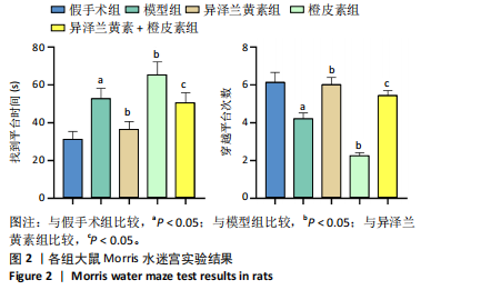
2.3 异泽兰黄素对蛛网膜下腔出血模型大鼠学习记忆能的影响 与假手术组相比,模型组大鼠找到平台时间增加(P < 0.05),穿越平台次数减少(P < 0.05);与模型组相比,异泽兰黄素组大鼠找到平台时间减少(P < 0.05)、穿越平台次数增加(P < 0.05),橙皮素组大鼠找到平台时间增加(P < 0.05)、穿越平台次数减少(P < 0.05);与异泽兰黄素组相比,异泽兰黄素+橙皮素组大鼠找到平台时间增加(P < 0.05),穿越平台次数减少(P < 0.05),见图2。 2.4 异泽兰黄素对蛛网膜下腔出血模型大鼠海马组织病理变化的影响 苏木精-伊红染色结果显示,假手术组大鼠海马区结构正常,细胞染色清晰,排列整齐;与假手术组相比,模型组神经细胞核出现皱缩现象,细胞数量有所减少,细胞排列杂乱;与模型组相比,异泽兰黄素组细胞排列较为整齐,橙皮素组神经细胞排列更为杂乱,"
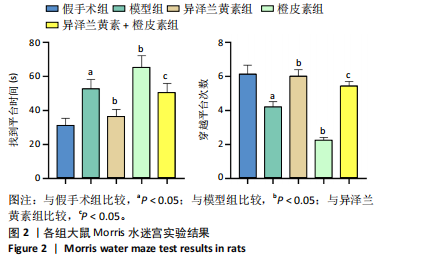
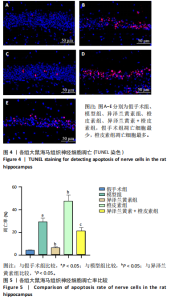
2.5 异泽兰黄素对蛛网膜下腔出血模型大鼠海马组织神经细胞凋亡的影响 TUNEL染色结果显示,与假手术组相比,模型组大鼠海马组织细胞凋亡率升高(P < 0.05);与模型组相比,异泽兰黄素组大鼠海马组织细胞凋亡率降低(P < 0.05),橙皮素组大鼠海马组织细胞凋亡率升高(P < 0.05);与异泽兰黄素组相比,异泽兰黄素+橙皮素组大鼠海马组织细胞凋亡率升高(P < 0.05),见图4,5。 2.6 异泽兰黄素对蛛网膜下腔出血模型大鼠双皮质素蛋白表达的影响 免疫荧光染色结果显示,与假手术组相比,模型组大鼠双皮质素阳性细胞数减少(P < 0.05);与模型组相比,异泽兰黄素组大鼠双皮质素阳性细胞数增加(P < 0.05),橙皮素组大鼠双皮质素阳性细胞数减少(P < 0.05);与异泽兰黄素组相比,异泽兰黄素+橙皮素组大鼠双皮质素阳性细胞数减少(P < 0.05),见图6,7。"
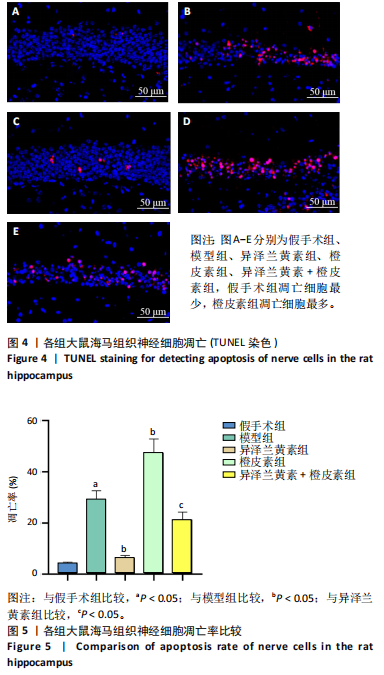
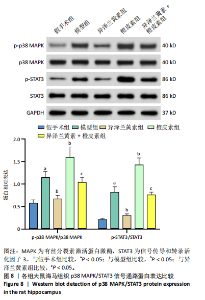
2.7 异泽兰黄素对蛛网膜下腔出血模型大鼠海马组织p38 MAPK/STAT3信号通路蛋白表达的影响 Western blot法检测结果显示,与假手术组相比,模型组大鼠海马组织p-p38 MAPK/p38 MAPK、p-STAT3/STAT3蛋白表达升高(P < 0.05);与模型组相比,异泽兰黄素组大鼠海马组织p-p38 MAPK/p38 MAPK、p-STAT3/STAT3蛋白表达降低(P < 0.05),橙皮素组大鼠海马组织p-p38 MAPK/p38 MAPK、p-STAT3/STAT3蛋白表达升高(P < 0.05);与异泽兰黄素组相比,异泽兰黄素+橙皮素组大鼠海马组织p-p38 MAPK/p38 MAPK、p-STAT3/STAT3蛋白表达升高(P < 0.05),见图8。"
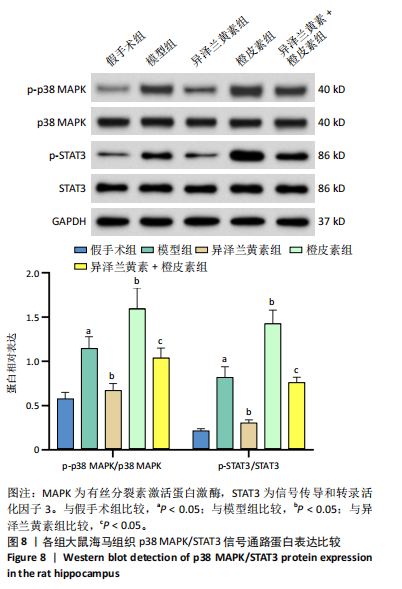
| [1] SCHATLO B, FUNG C, STIENEN MN, et al. Incidence and outcome of aneurysmal subarachnoid hemorrhage: the swiss study on subarachnoid hemorrhage (Swiss SOS). Stroke. 2021;52(1):344-347. [2] LAUZIER DC, JAYARAMAN K, YUAN JY, et al. Early brain injury after subarachnoid hemorrhage: incidence and mechanisms. Stroke. 2023; 54(5):1426-1440. [3] DENG X, LIANG C, QIAN L, et al. miR-24 targets HMOX1 to regulate inflammation and neurofunction in rats with cerebral vasospasm after subarachnoid hemorrhage. Am J Transl Res. 2021;13(3):1064-1074. [4] JUNG H, YOUN DH, PARK JJ, et al. Bone-marrow-derived mesenchymal stem cells attenuate behavioral and cognitive dysfunction after subarachnoid hemorrhage via HMGB1-RAGE axis mediation. Life (Basel). 2023;13(4):881. [5] BAI D, SUN T, LU F, et al. Eupatilin suppresses OVA-induced asthma by inhibiting NF-κB and MAPK and activating Nrf2 signaling pathways in mice. Int J Mol Sci. 2022;23(3):1582. [6] KIM K, HONG HL, KIM GM, et al. Eupatilin ameliorates lipopolysaccharide-induced acute kidney injury by inhibiting inflammation, oxidative stress, and apoptosis in mice. Curr Issues Mol Biol. 2023;45(9):7027-7042. [7] ZHOU Y, ZHANG X, GUO Y, et al. Eupatilin mitigates Gestational diabetes in streptozotocin-induced diabetic pregnant rats through the Regulation of inflammation and oxidative stress. Heliyon. 2024;10(10):e30911. [8] ROSA A, PIRAS F, POLLASTRO F, et al. Comparative evaluation of anticancer activity of natural methoxylated flavones xanthomicrol and eupatilin in A375 skin melanoma cells. Life (Basel). 2024;14(3):304. [9] 申友奎,王雁秋,刘飞飞,等.异泽兰黄素对脑出血小鼠的神经保护作用及氧化应激和神经元凋亡的影响[J].中国中医药科技, 2024,31(2):226-230,268. [10] QIAO HB, LI J, LV LJ, et al. Eupatilin inhibits microglia activation and attenuates brain injury in intracerebral hemorrhage. Exp Ther Med. 2018;16(5):4005-4009. [11] HONG Y, HE S, ZOU Q, et al. Eupatilin alleviates inflammatory response after subarachnoid hemorrhage by inhibition of TLR4/MyD88/NF-κB axis. J Biochem Mol Toxicol. 2023;37(5):e23317. [12] SUN P, MA F, XU Y, et al. Genetic deletion of endothelial microRNA-15a/16-1 promotes cerebral angiogenesis and neurological recovery in ischemic stroke through Src signaling pathway. J Cereb Blood Flow Metab. 2021;41(10):2725-2742. [13] AMINI H, KNEPP B, RODRIGUEZ F, et al. Early peripheral blood gene expression associated with good and poor 90-day ischemic stroke outcomes. J Neuroinflammation. 2023;20(1):13. [14] LIU M, ZHONG W, LI C, et al. Fluoxetine attenuates apoptosis in early brain injury after subarachnoid hemorrhage through Notch1/ASK1/p38 MAPK signaling pathway. Bioengineered. 2022;13(4):8396-8411. [15] WANG X, ZHANG A, YU Q, et al. Single-cell rna sequencing and spatial transcriptomics reveal pathogenesis of meningeal lymphatic dysfunction after experimental subarachnoid hemorrhage. Adv Sci (Weinh). 2023;10(21):e2301428. [16] LIU Z, WANG B, GUO Q. MiR-26b-5p-modified hUB-MSCs derived exosomes attenuate early brain injury during subarachnoid hemorrhage via MAT2A-mediated the p38 MAPK/STAT3 signaling pathway. Brain Res Bull. 2021;175:107-115. [17] DUAN H, LI L, SHEN S, et al. Hydrogen sulfide reduces cognitive impairment in rats after subarachnoid hemorrhage by ameliorating neuroinflammation mediated by the TLR4/NF-κB pathway in microglia. Front Cell Neurosci. 2020;14:210. [18] 孙林林,张兴祥,李建民,等.法舒地尔对大鼠蛛网膜下腔出血早期脑损伤的行为能力及海马区神经细胞凋亡的影响[J].中国老年学杂志,2019,39(10):2481-2484. [19] 刘振刚,高建亮,孙林林,等.颈内动脉刺破法制作大鼠蛛网膜下腔出血模型[J].中国比较医学杂志,2017,27(6):37-45. [20] GARCIA JH, WAGNER S, LIU KF, et al. Neurological deficit and extent of neuronal necrosis attributable to middle cerebral artery occlusion in rats. Statistical validation. Stroke. 1995;26(4):627-634. [21] EL AMKI M, DUBOIS M, LEFEVRE-SCELLES A, et al. Long-Lasting Cerebral Vasospasm, Microthrombosis, Apoptosis and Paravascular Alterations Associated with Neurological Deficits in a Mouse Model of Subarachnoid Hemorrhage. Mol Neurobiol. 2018;55(4):2763-2779. [22] LIU C, YAO K, TIAN Q, et al. CXCR4-BTK axis mediate pyroptosis and lipid peroxidation in early brain injury after subarachnoid hemorrhage via NLRP3 inflammasome and NF-κB pathway. Redox Biol. 2023;68:102960. [23] ANDERSEN CR, PRESSEAU J, SAIGLE V, et al. Core outcomes for subarachnoid haemorrhage. Lancet Neurol. 2019;18(12):1075-1076. [24] JUNG H, YOUN DH, PARK JJ, et al. Bone-marrow-derived mesenchymal stem cells attenuate behavioral and cognitive dysfunction after subarachnoid hemorrhage via HMGB1-RAGE axis mediationv. Life (Basel). 2023;13(4):881. [25] ZHANG Y, QIN L, XIE J, et al. Eupatilin prevents behavioral deficits and dopaminergic neuron degeneration in a Parkinson’s disease mouse model. Life Sci. 2020;253(1):117745-117756. [26] FEI X, CHEN C, KAI S, et al. Eupatilin attenuates the inflammatory response induced by intracerebral hemorrhage through the TLR4/MyD88 pathway. Int Immunopharmacol. 2019;76(1):105837-105846. [27] CAO Y, WANG Y, LI X, et al. MCC950 ameliorates cognitive function by reducing white matter microstructure damage in rats after SAH. Brain Res Bull. 2023;202:110743. [28] VERON AD, BIENBOIRE-FROSINI C, GIRARD SD, et al. Syngeneic transplantation of olfactory ectomesenchymal stem cells restores learning and memory abilities in a rat model of global cerebral ischemia. Stem Cells Int. 2018;2018(1):2683969-2683978. [29] JEON J, MONY TJ, CHO E, et al. Role of extracellular signal-regulated kinase in rubrofusarin-enhanced cognitive functions and neurite outgrowth. Biomed Pharmacother. 2022;147:112663. [30] ZUO Y, WANG J, ENKHJARGAL B, et al. Neurogenesis changes and the fate of progenitor cells after subarachnoid hemorrhage in rats. Exp Neurol. 2019;311(1):274-284. [31] KUIL LE, SEIGERS R, LOOS M, et al. Fractionated brain X-irradiation profoundly reduces hippocampal immature neuron numbers without affecting spontaneous behavior in mice. Heliyon. 2024;10(9):e29947. [32] LEE S, LEE W, YANG S, et al. Di-n-butyl phthalate disrupts neuron maturation in primary rat embryo neurons and male C57BL/6 mice. J Toxicol Environ Health A. 2022;85(2):56-70. [33] ZUO Y, WANG J, LIAO F, et al. Inhibition of heat shock protein 90 by 17-AAG reduces inflammation via P2X7 receptor/NLRP3 inflammasome pathway and increases neurogenesis after subarachnoid hemorrhage in mice. Front Mol Neurosci. 2018;11(1):401-416. [34] WAN T, WANG Z, LUO Y, et al. FA-97, a new synthetic caffeic acid phenethyl ester derivative, protects against oxidative stress-mediated neuronal cell apoptosis and scopolamine-induced cognitive impairment by activating Nrf2/HO-1 signaling. Oxid Med Cell Longev. 2019;2019(1): 8239642-8239663. [35] OU S, KIM TY, JUNG E, et al. p38 mitogen-activated protein kinase contributes to TNFα-induced endothelial tube formation of bone-marrow-derived mesenchymal stem cells by activating the JAK/STAT/TIE2 signaling axis. BMB Rep. 2024;57(5):238-243. [36] HUANG C, DONG J, CHENG L, et al. Alkaloids from aconitum carmichaelii alleviates DSS-induced ulcerative colitis in mice via MAPK/NF-κB/STAT3 signaling inhibition. Evid Based Complement Alternat Med. 2022;2022:6257778. [37] Choi JY, Yun J, Hwang CJ, et al. (E)-2-methoxy-4-(3-(4-methoxyphenyl) prop-1-en-1-yl) phenol Ameliorates MPTP-induced dopaminergic neurodegeneration by inhibiting the STAT3 pathway. Int J Mol Sci. 2019;20(11):2632-2647. [38] CHEN CM, YEN CY, CHEN WL, et al. Pathomechanism characterization and potential therapeutics identification for Parkinson’s Disease targeting neuroinflammation. Int J Mol Sci. 2021;22(3):1062. [39] WU CR, YANG QY, CHEN QW, et al. Ghrelin attenuate cerebral microvascular leakage by regulating inflammation and apoptosis potentially via a p38 MAPK-JNK dependent pathway. Biochem Biophys Res Commun. 2021;552:37-43. |
| [1] | Fang Yuan, Qian Zhiyong, He Yuanhada, Wang Haiyan, Sha Lirong, Li Xiaohe, Liu Jing, He Yachao, Zhang Kai, Temribagen. Mechanism of Mongolian medicine Echinops sphaerocephalus L. in proliferation and angiogenesis of vascular endothelial cells [J]. Chinese Journal of Tissue Engineering Research, 2025, 29(35): 7519-7528. |
| [2] | Li Chen, Liu Ye, Ni Xindi, Zhang Yuang. Simulation analysis of real-time continuous stiffness in muscle fibers and tendons of the triceps surae during multi-joint movement [J]. Chinese Journal of Tissue Engineering Research, 2025, 29(35): 7529-7536. |
| [3] | Yang Bo, Pan Xinfang, Chang Liuhui, Ni Yong. Correlation of echocardiographic parameters with disability at 3 months after acute ischemic stroke [J]. Chinese Journal of Tissue Engineering Research, 2025, 29(35): 7544-7551. |
| [4] | Liu Xuan, Ding Yuqing, Xia Ruohan, Wang Xianwang, Hu Shujuan. Exercise prevention and treatment of insulin resistance: role and molecular mechanism of Keap1/nuclear factor erythroid2-related factor 2 signaling pathway [J]. Chinese Journal of Tissue Engineering Research, 2025, 29(35): 7578-7588. |
| [5] | Gong Yuehong, Wang Mengjun, Ren Hang, Zheng Hui, Sun Jiajia, Liu Junpeng, Zhang Fei, Yang Jianhua, Hu Junping. Machine learning combined with bioinformatics screening of key genes for pulmonary fibrosis associated with cellular autophagy and experimental validation [J]. Chinese Journal of Tissue Engineering Research, 2025, 29(35): 7679-7689. |
| [6] | Han Jie, Pan Chengzhen, Shang Yuzhi, Zhang Chi. Identification of immunodiagnostic biomarkers and drug screening for steroid-induced osteonecrosis of the femoral head [J]. Chinese Journal of Tissue Engineering Research, 2025, 29(35): 7690-7700. |
| [7] | Lu Xiuli, Xu Huazhen, Chen Yuxing, Yao Nan, Hu Zixuan, Huang Dane. Mechanism of Jiangu Formula in treating osteoporosis based on osteoclast-osteoblast coupling [J]. Chinese Journal of Tissue Engineering Research, 2025, 29(32): 6828-6835. |
| [8] | Yan Laijun, Ge Haiya, Wang Zhengming, Yang Zongrui, Niu Lifeng, Zhan Hongsheng. Mechanism by which Tongdu Huoxue Decoction inhibits macrophage inflammation to delay intervertebral disc degeneration in rats [J]. Chinese Journal of Tissue Engineering Research, 2025, 29(32): 6851-6857. |
| [9] | Nigeayi · Aihemaiti, Yilidanna · Dilixiati, An Wei, Maimaitituxun · Tuerdi. Expression of mitochondrial creatine kinase 2 in a rat model of temporomandibular joint osteoarthritis and its role in inflammation progression [J]. Chinese Journal of Tissue Engineering Research, 2025, 29(32): 6877-6884. |
| [10] | Wang Ziheng, Wu Shuang. Oxidative stress-related genes and molecular mechanisms after spinal cord injury: data analysis and verification based on GEO database [J]. Chinese Journal of Tissue Engineering Research, 2025, 29(32): 6893-6904. |
| [11] |
Zhou Rulin, Hu Yuanzheng, Wang Zongqing, Zhou Guoping, Zhang Baochao, Xu Qian, Bai Fanghui.
Exploration of biomarkers for moyamoya disease and analysis of traditional Chinese medicine targets#br#
#br#
[J]. Chinese Journal of Tissue Engineering Research, 2025, 29(32): 6927-6938.
|
| [12] | Zhao Xuemei, Wang Rui, Ao · Wuliji, Bao Shuyin, Jiang Xiaohua. Effects of Agiophyllum Oligo Saccharides on inflammation and apoptosis of mouse synovial cells [J]. Chinese Journal of Tissue Engineering Research, 2025, 29(32): 6939-6946. |
| [13] | Zhu Jiaping, Gao Bo, Lou Chunbiao, Yang Fengyong, Yang Kun. Monomeric traditional Chinese medicine in the treatment of rheumatoid arthritis: regulation of T cell balance [J]. Chinese Journal of Tissue Engineering Research, 2025, 29(32): 6955-6962. |
| [14] | Yao Tingfeng, Liu Lin, Liu Shixuan, Lu Xinyue. Meta-analysis of the effectiveness of dry needling at myofascial trigger points in the treatment of knee disorders [J]. Chinese Journal of Tissue Engineering Research, 2025, 29(32): 6989-6996. |
| [15] | Wu Zhenhua, Zhang Xiwei, Wang Yipin, Li Qianqian. Relationship between seven serum lipid traits and osteoarthritis: a large sample analysis of European population in IEU OPEN GWAS database [J]. Chinese Journal of Tissue Engineering Research, 2025, 29(32): 7004-7014. |
| Viewed | ||||||
|
Full text |
|
|||||
|
Abstract |
|
|||||
